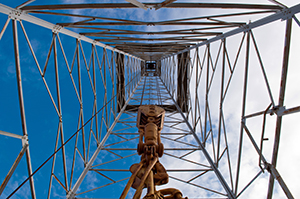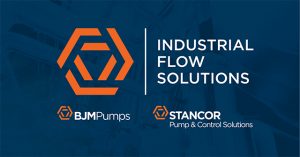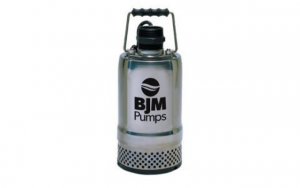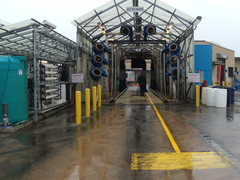According to the US Energy Information Administration (EIA), oil and gas production in the United States in August 2014 was at its highest volume since 1986. More than half of this production comes from basins in three states — Texas, New Mexico and North Dakota. The oilfield can be a harsh environment for those working in it and for the equipment that supports their efforts. The rigs are often located in remote areas that may be subject to extreme weather conditions. And although the rugged terrain may be barren, the site still has to be prepared to accommodate the rig and all of the required equipment, hundreds of feet of pipe, and one or more pits for drilling mud and other fluids. Before drilling can begin the site must be cleared and leveled and in some cases access roads need to be built. A source of water is also required, which may mean drilling a water well, and one or more pits are dug and lined.
Fluids play an integral role in oil and gas exploration and production. When a new well is drilled, some form of fluid is needed. The base of this drilling fluid, or mud, can be freshwater or saltwater (brine) or it may be an oil- or synthetic-based liquid. The type of fluid and the additives used are determined in part based on the composition of the rock being drilled into. Cost and environmental impact are also considerations. The mud may also be modified as drilling progresses and the underground environment changes. The mud serves a number of important functions:
- lubricating and cooling the drill bit, thereby extending its life
- transporting rock fragments (cuttings) to the surface,
- preventing the wellbore from caving in before the casing is inserted, and
- preventing the oil or gas from entering the well before it’s completed.
Ideally and increasingly, this fluid is recycled during drilling. To facilitate reuse, cuttings are allowed to settle out in a pit and the resulting liquid is pumped back to the wellbore.
Water is often a natural byproduct of the drilling and production process. Water may be trapped underground along with the oil and gas. Sometimes this produced water is incorporated and used in the drilling process.
This simple overview illustrates the fact that drilling a new well is a complicated process with many moving parts — literally. A variety of providers are necessary at different times to deliver their unique services until a well is completed.
Moving oilfield fluids require pumps
Not surprisingly, moving all of this liquid requires pumps. United Rentals – Pump Solutions is a large equipment rental provider with dedicated experts who work with operators and other service providers to find solutions for a variety of challenges. In West Texas, those challenges often occur in the oilfield. United Rentals was approached by West Texas Premix Pits (WTPP) of Midland, Texas, to help with a solution for a new application.
WTPP manufactures and sells premix pits, trash pumps and safety showers to oil and gas drillers in the Midland–Odessa area. Some of its clients were looking for an efficient solution to pump and recirculate spent drilling mud. Ian Walker, sales representative for United Rentals, recommended BJM Pumps KZN series heavy duty submersible pump.
“We really like the durability of BJM in the oilfield,” Walker said. “These pumps handle a lot of solids a lot better than most other electric submersible pumps we’ve seen and they hold up better.”
Among other things, WTPP installs and maintains the reserve pits used during oil exploration. The pits are roughly one-acre ponds that hold from two to ten feet of drilling fluid that can be from brine or freshwater. The mud coming up out of the hole with the cuttings is deposited into one side of the pit and allowed to settle out, and the fluid that’s reused is pumped out of the other side of the pit. Although using a conventional pit configuration, WTPP is trying something new with its pumps — floating them on top of the liquid in the pit. WTPP builds specialized baskets to hold the pumps so they’re sitting in just six to eight inches of water.
“It helps the drilling rig pick up cleaner fluid because the pumps are taking fluid off the top,” said Danny Freeman, owner of WTPP. “As the stuff settles out they have cleaner drilling fluid, and that results in faster drilling.”
WTPP initially rented BJM’s KZN series pumps from United Rental, but after they proved their worth, they decided to buy. “They were great pumps so we stuck with them,” Freeman said.
Although WTPP’s floating configuration has minimized the pumps exposure to solids, the oilfield environment still presents challenges for these pumps, particularly if the water is brine. “Salt water is hard on anything,” Freeman said. “I have customers flush the pump on a regular basis to keep it from getting corroded.”
Although not maintenance free, KZN series pumps are rugged enough to provide reliable long-term operation in even the harshest of drilling environments, including those where the pumps have to handle a greater percentage of solids. Some of the characteristics that set the KZN series apart from other pumps are:
- Optimum Wear Resistance. All wetted parts are constructed of
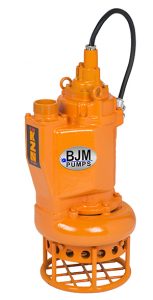 abrasive resistant 28 percent chrome iron (600 Brinell, 71 Rockwell C) for maximum wear life. In addition, a replaceable hardened wear plate is located on the suction side, where erosion would cause a loss of pump
abrasive resistant 28 percent chrome iron (600 Brinell, 71 Rockwell C) for maximum wear life. In addition, a replaceable hardened wear plate is located on the suction side, where erosion would cause a loss of pump - Maximum Solids Handling Capability. An integral agitator fluidizes settled solids into a slurry making them easier to pump with less chance of The semi-open impeller handles abrasive solid concentrations as high as 70 percent by weight.
Other factors that make the KZN Series pumps ideal for challenging environments are:
- Class H motor insulation and built in amperage ( FLA ) and temperature overload protection;
- Double silicon carbide mechanical seals in a separate oil filled seal chamber;
- Heavy duty lip seal that provides additional protection for the mechanical seals;
- Stainless steel shaft and shaft sleeve that provide maximum wear and corrosion protection;
- Pump volutes cast from hardened ductile iron (300 Brinell hardness), which is twice as abrasive resistant as standard ductile iron with walls that are extra thick at the point where pumped slurry enters the discharge.
(Specifications may differ among models.)
Conclusion
As a result of the success they’ve had with the KZN pumps over the past two years, WTPP now operates 11 of the pumps in various oilfield installations across West Texas.
“We’ve been very pleasantly surprised with the durability and reliability of them,” Freeman said. “They were a great pump so we stuck with them.”
About the Author
Mike Bjorkman is Vice President of BJM Corp. and has more than 30 years of experience in the pump industry. He serves as Director of Marketing and IT for BJM Pumps, LLC and All Test Pro, LLC. Both companies are subsidiaries of BJM Corp. Mike can be reached at 1-860-399-5937.
About BJM Pumps
BJM Pumps, established in 1983, supplies electrical submersible pumps to industrial and municipal markets throughout the United States, Canada and South America. BJM Corp. is headquartered in Old Saybrook, Conn. For more information, visit www.bjmpumps.com.
About West Texas Premix Pits
West Texas Premix Pits is an oil field equipment rental company that manufactures and sells premix pits, trash pumps and safety showers in the Midland-Odessa area of West Texas. Visit http://premixpits.com for more information.
About United Rentals
Founded in 1997, United Rentals has become the world’s largest equipment rental provider, with an integrated network of 832 rental locations in 49 states and 10 Canadian provinces. United Rentals Pump Solutions provides industrial-grade equipment for fluid transfer, flow control, bypass and groundwater management applications. Visit www.unitedrentals.com to learn more.

